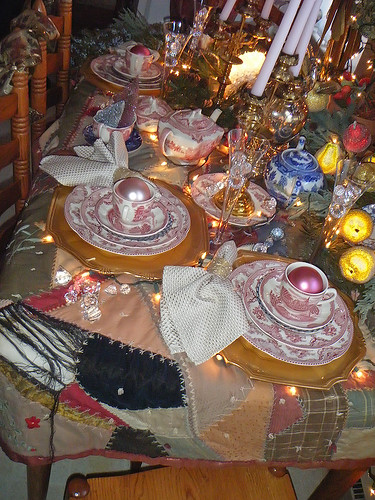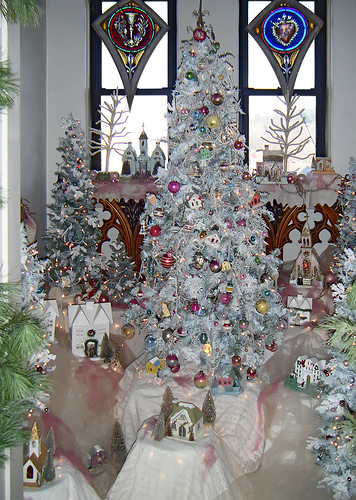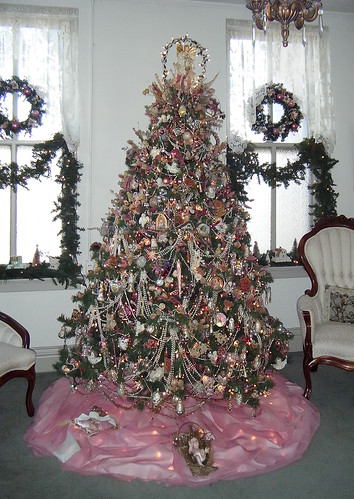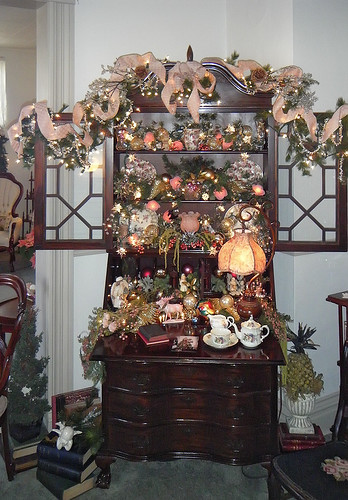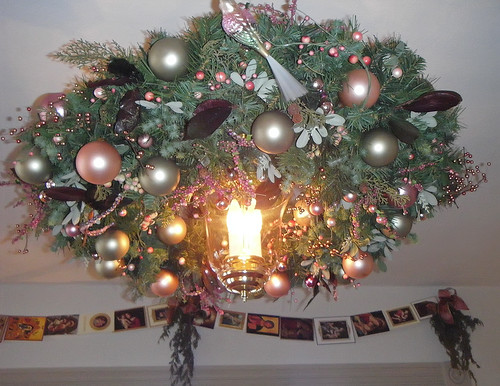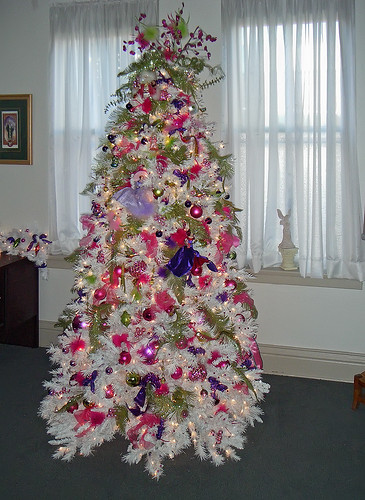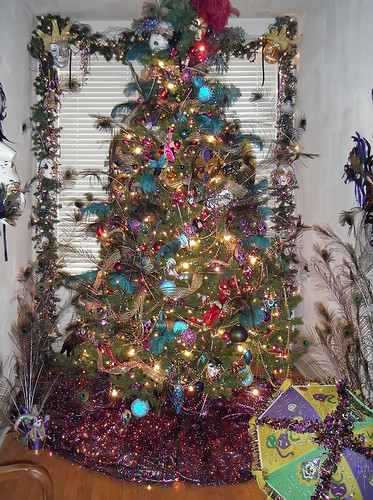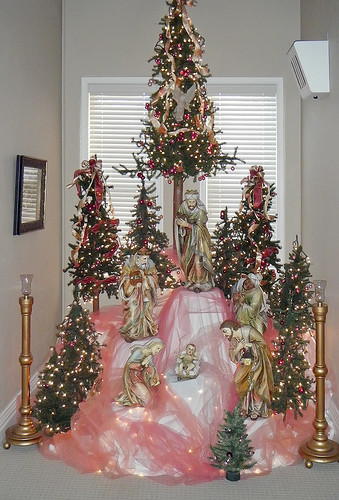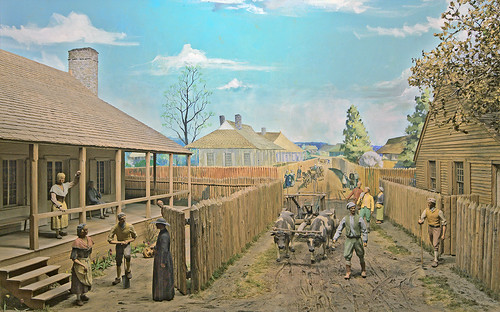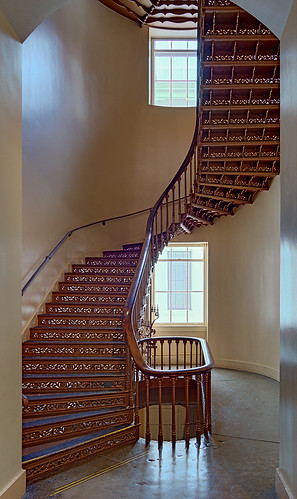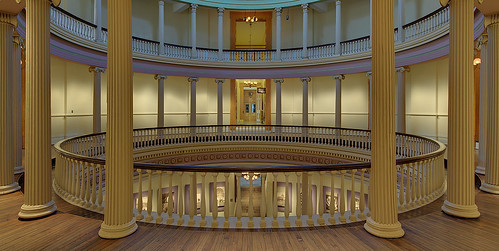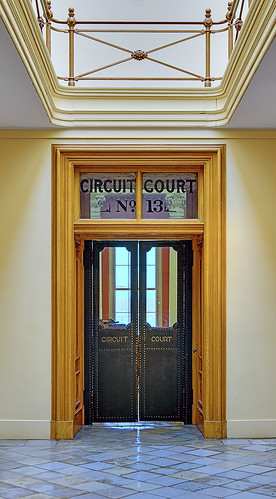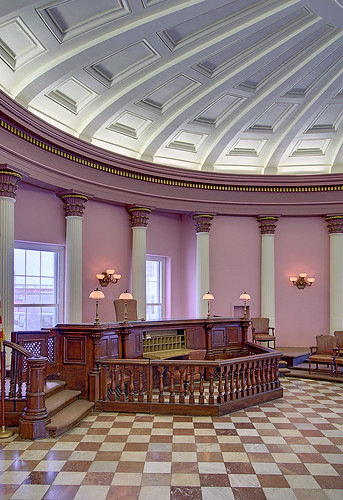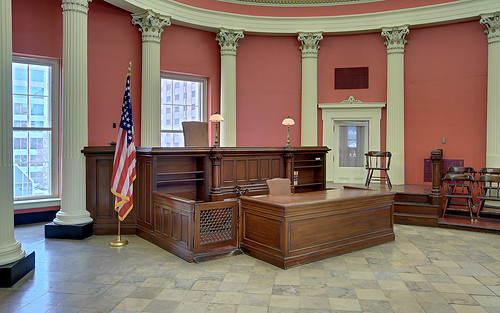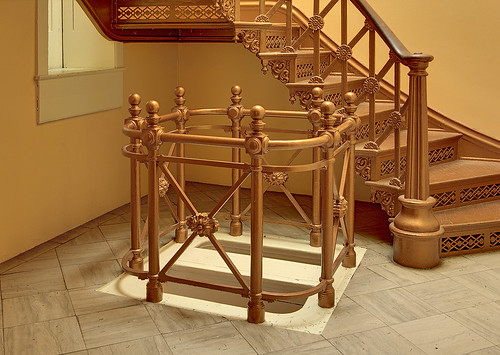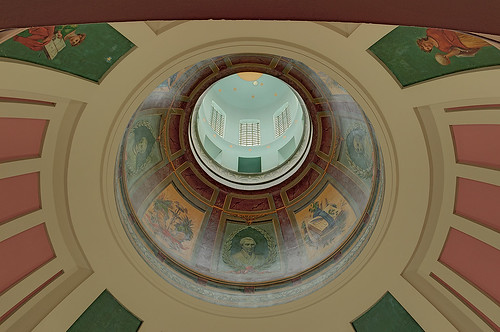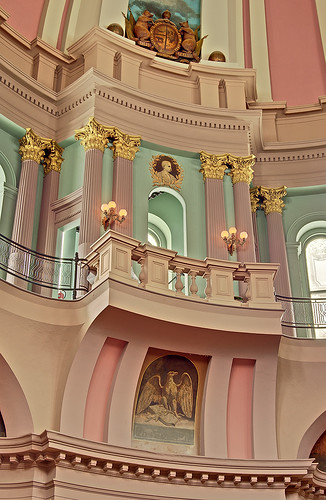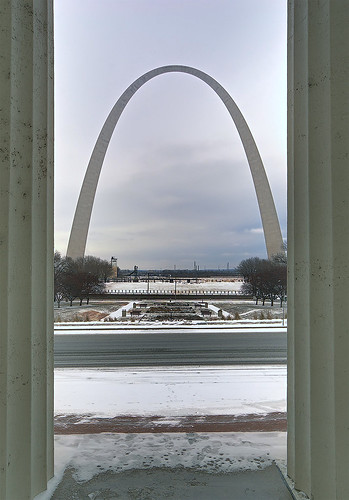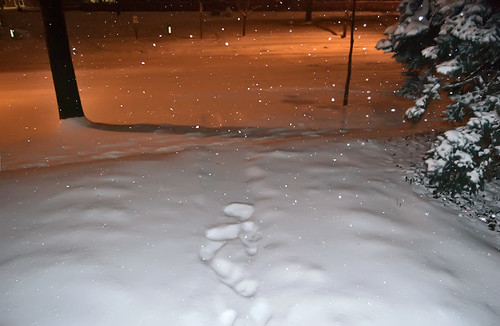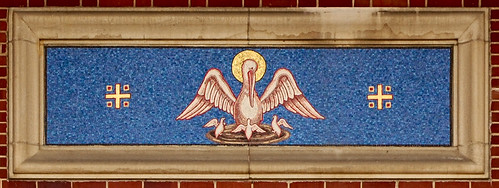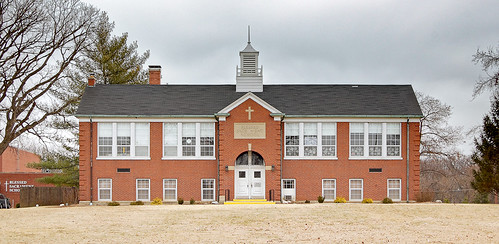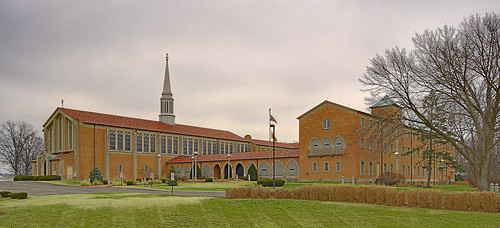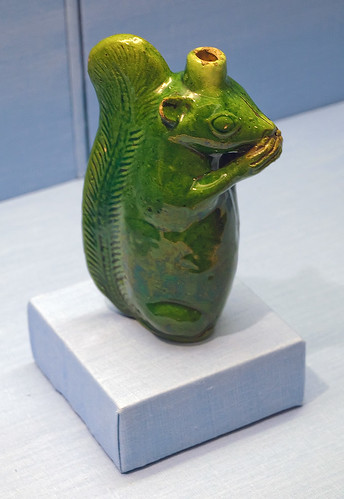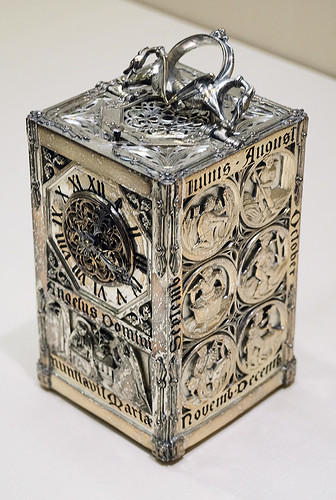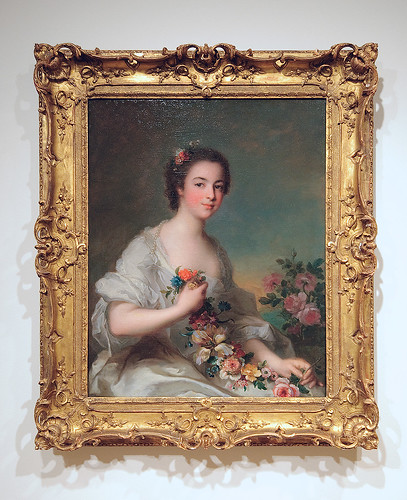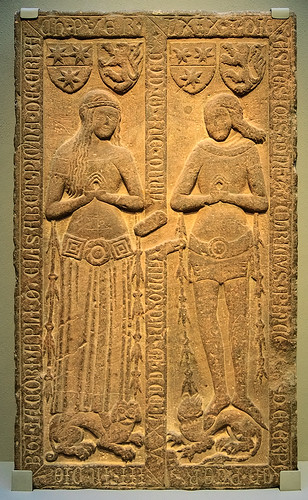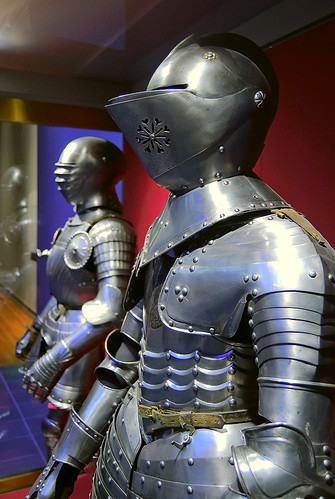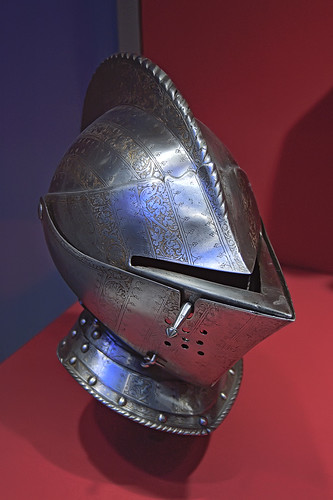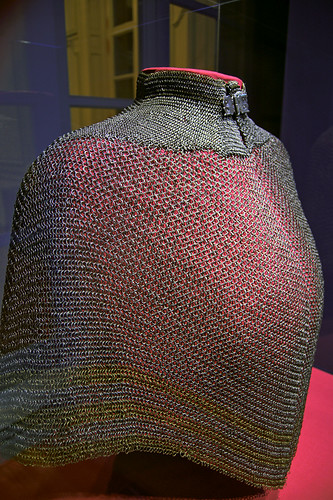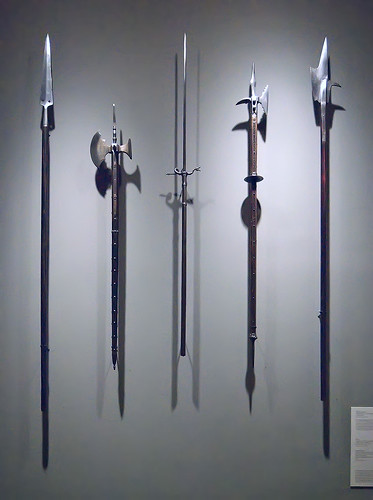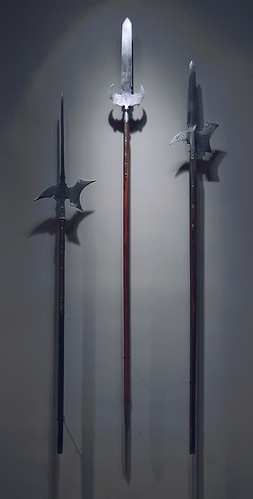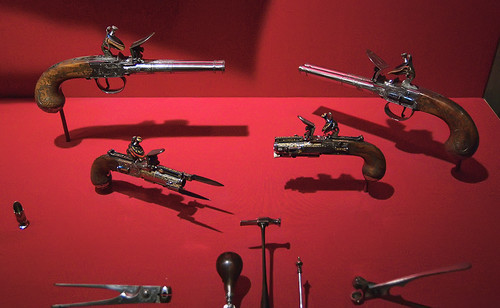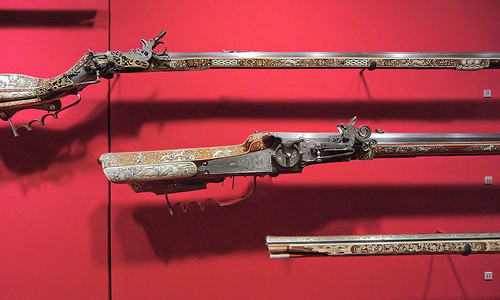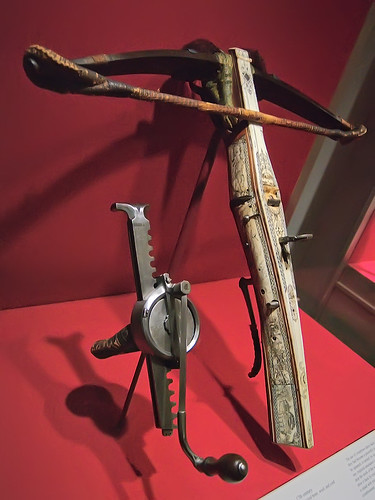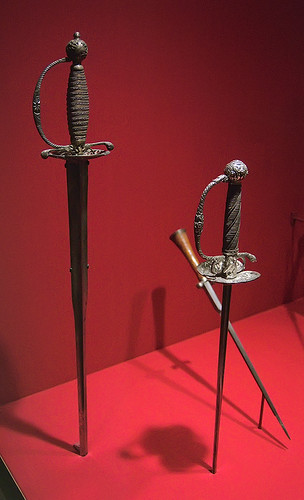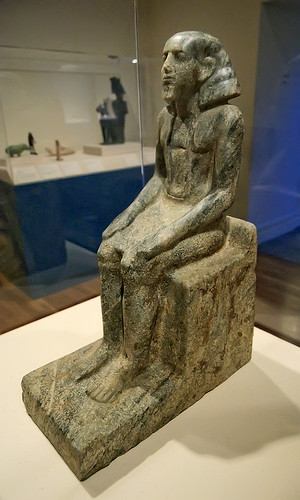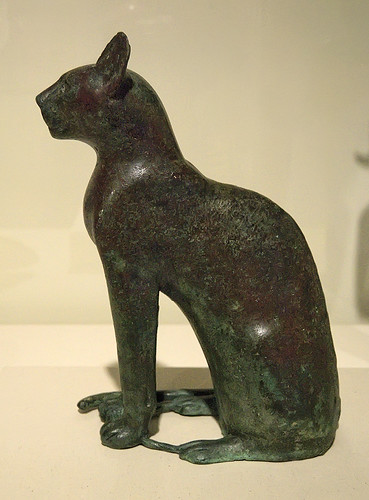On Saturday, January 31, 2009, at 11:00 a.m. St Agatha parish will honor the parish's patron saint with a special Mass celebrated by Bishop Zygmunt Zimowski of the Diocese of Radom in Poland, who is also a pastoral guardian for Poles living abroad. Bishop Robert Hermann and Rev. Msgr. Vernon Gardin will be present for this occasion.Click here for some of my old photos of the church.
Two special guest soloists from Warsaw Opera Theatre, Ryszard Wróblewski and Edyta Ciechomska-Bilska, will be performing during Mass and will give a short concert following the Mass (around 12:30 p.m.) in the Church. Following the concert, you are invited to join the parishioners for a luncheon with all the Bishops in the School Ballroom. Another concert will also be given at St. Agatha Church on Sunday, February 1, at 2 p.m.
Both soloists have accomplished musical careers: Ryszard Wróblewski, a tenor, is currently with the Grand Theatre in Warsaw. He gave performances at many prestigious opera theatres including Gdańsk, Warsaw and Poznań. He also performed internationally in Europe and the United States. His extensive repertoire includes a great number of tenor parts, such as, Don Jose in Bizet’s "Carmen," Stefan in Moniuszko’s "Haunted Manor," Pinkerton in "Madame Butterfly," Cavaradossi in Puccini’s "Tosca," etc. Tenor Wróblewski also performs oratorio, cantata and concert repertoire.
In 1995, soprano Edyta Ciechomska-Bilska graduated with honors from the musical academy in Warsaw. She is a laureate of Polish and international opera gala competitions. Even as a student, she took part in productions of Warsaw’s Grand Theatre and Warsaw’s Opera Theatre. As a professional artist, she has been a member of the Roma Musical Theatre in Warsaw. Her performances include among many: "Madame Butterfly," Micaela in "Carmen" and Pamina in "Magic Flute." Edyta Ciechomska-Bilska has performed many concerts in Poland and abroad.
Pages
Thursday, January 29, 2009
"Bishop Zimowski of Poland to Celebrate Mass at St. Agatha Church"
A Psalm of Thanksgiving
1 A psalm of praise.2 Sing joyfully to God, all the earth: serve ye the Lord with gladness. Come in before his presence with exceeding great joy.
3 Know ye that the Lord he is God: he made us, and not we ourselves. We are his people and the sheep of his pasture.
4 Go ye into his gates with praise, into his courts with hymns: and give glory to him. Praise ye his name:
5 For the Lord is sweet, his mercy endureth for ever, and his truth to generation and generation.
REMINDER - Feast of Saint Francis de Sales and Mass for Journalists
On Thursday, January 29- 6:30pm, the Institute of Christ the King Sovereign Priest, a young community in the Church based in Florence/Italy, honors one of its patrons, St. Francis de Sales. The saint was named also the patron of journalists and writers because of his exceptional ability to communicate truth in a positive, charitable and understandable manner. Having been a missionary priest in France and the Bishop of Geneva in the late seventeenth century, St. Francis wrote numerous pamphlets on the Catholic faith which were distributed at that time in much the same way as print media today.From Introduction to the Devout Life, by Saint Francis de Sales:
The Oratory and its rector, Canon Michael Wiener, invite especially all journalists to be part of a special evening: The Solemn High Mass will be celebrated in the classic Roman Rite and accompanied by Louis Vierne’s Messe Solenelle in C-sharp Minor for organ and choir. Because of its complexity, this music is rarely heard; it will be a fitting complement to the Gothic splendor of St. Francis de Sales and of this sublime liturgy.
The Oratory, which is located on the corner of Gravois and Ohio, presently organizes a campaign to restore the out- and inside of the magnificent structure, especially its 300- foot- high steeple. (For further information about this project see also: www.TraditionForTomorrow.com) or 314. 771. 3100.
...[S]in is shameful when we commit it, but when reduced to repentance and confession, it becomes salutary and honourable. Contrition and confession are in themselves so lovely and sweet-savoured, that they efface the ugliness and disperse the ill savour of sin. Simon the leper called Magdalene a sinner, but our Lord turned the discourse to the perfume of her ointment and the greatness of her love. If we are really humble, my daughter, our sins will be infinitely displeasing to us, because they offend God;—but it will be welcome and sweet to accuse ourselves thereof because in so doing we honour God; and there is always somewhat soothing in fully telling the physician all details of our pain.
When you come to your spiritual father, imagine yourself to be on Mount Calvary, at the Feet of the Crucified Saviour, Whose Precious Blood is dropping freely to cleanse you from all your sin. Though it is not his actual Blood, yet it is the merit of that outpoured Blood which is sprinkled over His penitents as they kneel in Confession. Be sure then that you open your heart fully, and put away your sins by confessing them, for in proportion as they are put out, so will the Precious Merits of the Passion of Christ come in and fill you with blessings.
Tell everything simply and with straightforwardness, and thoroughly satisfy your conscience in doing so. Then listen to the admonitions and counsels of God’s Minister, saying in your heart, “Speak, Lord, for Thy servant heareth.” It is truly God to Whom you hearken, forasmuch as He has said to His representatives, “Whoso heareth you, heareth Me.”
— CHAPTER XIX. How to make a General Confession.
Photos of the Old Courthouse, in downtown Saint Louis, Missouri
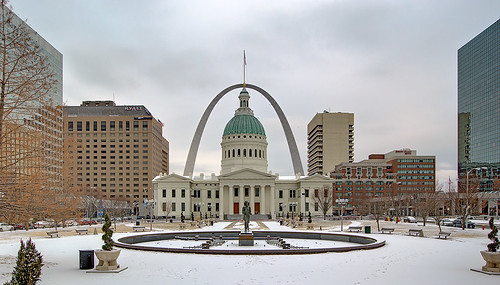
From the National Park Service website:
The original courthouse was constructed of brick in the Federal style of architecture and completed in 1828. The population of St. Louis grew three fold during this period due to the booming fur trade, and the courthouse was outgrown ten years after it opened. A second courthouse was designed by architect Henry Singleton, which incorporated the original courthouse as the east wing of the building.
The second courthouse was designed with four wings and a dome in the center of its axis. The cornerstone was laid in 1839 and within it were placed newspapers of various cities, an assortment of coins, and names of officers of government. Three tiers of balconies or galleries viewed the rotunda floor. Pillars of stone supported the first gallery, while white oak columns supported the upper two galleries. There were offices and courtrooms located throughout the building. The maximum number of courtrooms in use at one time was twelve, although fifteen different rooms were used over the duration of the courthouse's operations.
The Old Courthouse underwent a second period of construction beginning in 1851. The original brick courthouse was demolished and replaced with a new east wing. Between 1855 and 1858 the west wing was remodeled due to unsound second floor construction. The lower floor was divided into a hallway and two courtrooms to support the floor above. The Dred Scott trial occurred in the original lower west courtroom before it was remodeled.
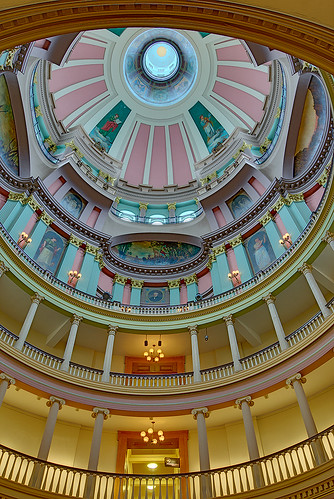
Due to the extensive remodeling, the original dome, a classic revival style, was replaced. The new dome was of wrought and cast iron with a copper exterior in an Italian Renaissance style. In 1861, the Federal government was constructing a similarly styled dome for the Capitol Building in Washington, D.C. Both domes were modeled after the dome in St. Peter's Basilica in Rome. Controversy was sparked when naysayers assumed the dome in St. Louis would be too heavy to be supported. The architect of the dome, William Rumbold, constructed a test model dome and proved it was sound. Once the dome was complete, Carl Wimar was commissioned to paint murals, in eye-shaped openings called "lunettes," on the interior of the dome. The subjects of the lunettes were four significant benchmarks in St. Louis history. A redecoration of Wimar's work occurred in 1880 by Ettore Miragoli with his own paintings. In 1888 August Becker restored the original Wimar paintings. Moisture and decay occurred over the years, and in 1905 and 1921 two more restorations were made.
The Old Courthouse was abandoned by the City of St. Louis in 1930 because the growth of the city required additional court space and a new structure had been completed a few blocks to the west. During the following ten years the older building was used for an art school and a workshop for a religious organization that refurbished toys for needy children. It also served as offices for two justices of the peace and their constables.
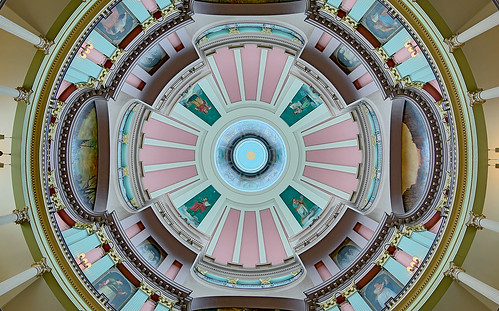
A dizzying view looking straight up. The dome has two layers; the interior is seen here, with a space above for maintenance of the exterior dome.

The limestone floor of the rotunda is worn smooth after over a century of use. The acoustics here are excellent; in the days before electronic sound amplification, public speakers could address large numbers of people on the floor and the three balconies. The Roman Emperor Constantine built a number of round churches of this layout, and we also find lecture halls of similar design in the ancient universities of Europe. Best acoustics are found if the speaker is off to one side.
Interview with Archbishop Burke

Photo of Hilary White and Archbishop Raymond Burke in Rome.
Click here for Hilary's exclusive interview with Archbishop Burke, at LifeSite News.
“A document of the US Catholic Bishops is partly to blame for the abandonment of pro-life teachings by voting Catholics and the election of the “most pro-abortion president” in US history, one of the Vatican’s highest officials said in an interview with LifeSiteNews.com.More tough talk from LifeSite:
“Archbishop Raymond Burke, the prefect of the Apostolic Signatura, named a document on the election produced by the US Conference of Catholic Bishops that he said “led to confusion” among the faithful and led ultimately to massive support among Catholics for Barack Obama.”
MUST READ: Bishop Hermann of St. Louis – Strongest Ever Pro-Life Column
Bishop Hermann: 'I thought you should know’
"Stimulus" Bill Still Includes $335 Million Handout for Condoms, Sex-Ed Programs
Tuesday, January 27, 2009
Sunday, January 25, 2009
Saint Louis in 1817
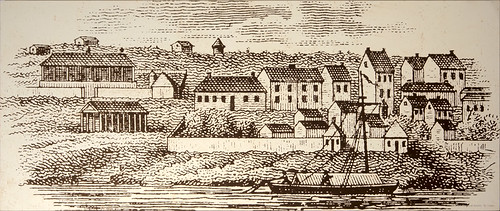
“This engraving on a ten dollar note issued by the Bank of St. Louis in 1817 provides the earliest known illustration of St. Louis.”
— from an exhibit at the Old Courthouse, in downtown Saint Louis, Missouri.This illustration shows a European-style walled town on the first terrace above the river, a vertical-log building to the left, and a watch-tower in the background.
Thursday, January 22, 2009
Rumor Has It...
I've also noticed that the media usually states that ‘improving relations with the SSPX’ is the only reason why Pope Benedict widened the availability of Mass according to the Latin Missale Romanum of 1962. Also, news reports just surfaced claiming that the SSPX is anti-Semitic: this at the same time as the rumor about the excommunications started. Connect the dots.
Wednesday, January 21, 2009
TELEGRAMMA DEL SANTO PADRE BENEDETTO XVI AL 44mo PRESIDENTE DEGLI STATI UNITI D’AMERICA BARACK OBAMA
THE HONORABLE BARACK OBAMASource.
PRESIDENT OF THE UNITED STATES OF AMERICA
THE WHITE HOUSE
WASHINGTON, DC
ON THE OCCASION OF YOUR INAUGURATION AS THE FORTY-FOURTH PRESIDENT OF THE UNITED STATES OF AMERICA I OFFER CORDIAL GOOD WISHES, TOGETHER WITH THE ASSURANCE OF MY PRAYERS THAT ALMIGHTY GOD WILL GRANT YOU UNFAILING WISDOM AND STRENGTH IN THE EXERCISE OF YOUR HIGH RESPONSIBILITIES. UNDER YOUR LEADERSHIP MAY THE AMERICAN PEOPLE CONTINUE TO FIND IN THEIR IMPRESSIVE RELIGIOUS AND POLITICAL HERITAGE THE SPIRITUAL VALUES AND ETHICAL PRINCIPLES NEEDED TO COOPERATE IN THE BUILDING OF A TRULY JUST AND FREE SOCIETY, MARKED BY RESPECT FOR THE DIGNITY, EQUALITY AND RIGHTS OF EACH OF ITS MEMBERS, ESPECIALLY THE POOR, THE OUTCAST AND THOSE WHO HAVE NO VOICE. AT A TIME WHEN SO MANY OF OUR BROTHERS AND SISTERS THROUGHOUT THE WORLD YEARN FOR LIBERATION FROM THE SCOURGE OF POVERTY, HUNGER AND VIOLENCE, I PRAY THAT YOU WILL BE CONFIRMED IN YOUR RESOLVE TO PROMOTE UNDERSTANDING, COOPERATION AND PEACE AMONG THE NATIONS, SO THAT ALL MAY SHARE IN THE BANQUET OF LIFE WHICH GOD WILLS TO SET FOR THE WHOLE HUMAN FAMILY (cf. Isaiah 25:6-7). UPON YOU AND YOUR FAMILY, AND UPON ALL THE AMERICAN PEOPLE, I WILLINGLY INVOKE THE LORD’S BLESSINGS OF JOY AND PEACE
BENEDICTUS PP. XVI
Tuesday, January 20, 2009
Photos of Blessed Sacrament Church, in Belleville, Illinois
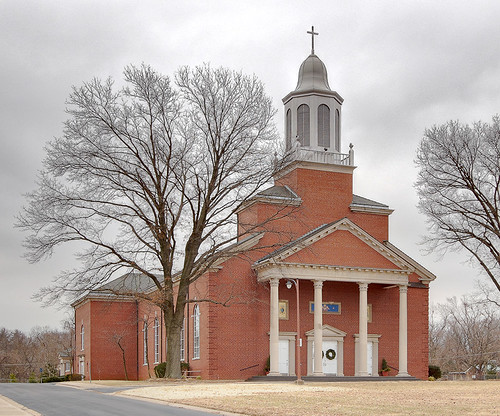
Prayer for those engaged in Public Affairs
OREMUS et pro omnibus res publicas moderantibus, eorumque ministeriis et potestatibus: ut Deus et Dominus noster mentes et corda eorum secundum voluntatem suam dirigat ad nostram perpetuam pacem.English translation:
Oremus. Flectamus genua… Levate.
Omnipotens sempiterne Deus, in cujus manu sunt omnium potestates et omnium jura populorum: respice benignus ad eos, qui nos in potestate regunt; ut ubique terrarum, dextera tua protegente, et religionis integritas, et patriæ securitas indesinenter consistat. Per Dominum... R. Amen.
Let us pray too for all engaged in affairs of state and for all their ministries and powers: that our God and Lord may guide according to His will their minds and hearts, to our lasting peace.
Let us pray. Let us kneel. Arise.
Almighty and everlasting God, in whose hands dwell all might and the rights of every people: look favorably on those who wield power over us; and let Thy right hand protect us, that, all the world through, both religious integrity and our country's security may be firmly based and abide. Through our Lord... R. Amen.
Auguries
“The establishment of our new Government seemed to be the last great experiment for promoting human happiness by reasonable compact in civil Society.”— Letter of George Washington to Catherine Macaulay Graham: New York, January 9th, 1790.
Sunday, January 18, 2009
Photo of Saint Mark Church, in Affton, Missouri
Friday, January 16, 2009
Looks Familiar
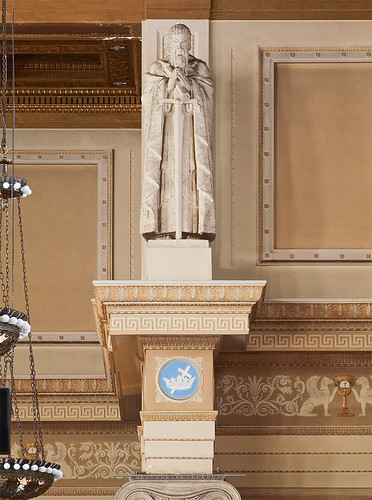
Back in September, 2007, I took this photo of a statue of Saint Paul, at the Cathedral of the Immaculate Conception, in Springfield, Illinois.
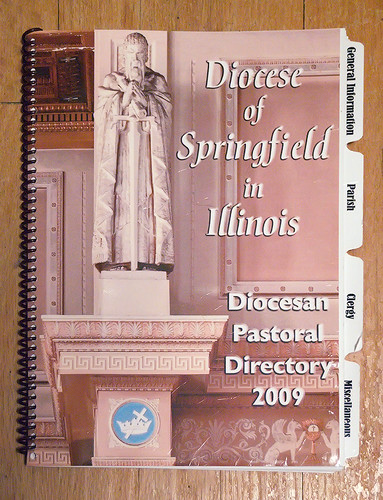
Here is the 2009 directory for the Diocese of Springfield in Illinois.
“In the Cathedral of the Immaculate Conception in Springfield, the statue of St. Paul the Apostle is located high above the main altar at the north side of the sanctuary. This photograph, by Mark Scott Abeln of St. Louis, was chosen for the cover of this year's pastoral directory in honor of the Pauline Year.”
Call No Man Happy
See the article It’s official: Make way for Obama Boulevard. Delmar Boulevard in Saint Louis is to be renamed in honor of our President-Elect.
The naming of things is a serious matter, best done with much consideration. Saint Louisians perhaps remember the embarrassment which followed the renaming of a stretch of Interstate 70 as the 'Mark McGwire Highway'.
Prudence tells us that we ought to wait until after someone is dead before we rename something in their honor. Or, at the very least, after the honoree has reached a ripe age, and has retired from public life.
But as it so happens, the City Aldermen hedged their bets, and only voted on an honorary renaming. Delmar is still the official street name, and only six street signs will be posted, along with — and not replacing — the existing signs.
Photo of Ruins in Tower Grove Park
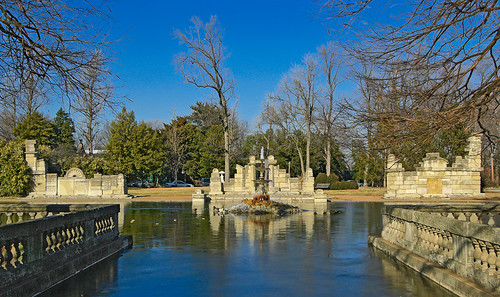
These picturesque "ruins" in Tower Grove Park, Saint Louis, Missouri, were actually assembled here by park founder Henry Shaw. They are remains from the Lindell Hotel, which was destroyed by fire in 1867. Admiration of old ruins had become popular by the European Grand Tour, and led to the construction of follies such as this.
Wednesday, January 14, 2009
Oratory to Offer Mass for Journalists

Institute of Christ the King Sovereign Priest
St. Francis de Sales Oratory
2653 Ohio Avenue
Saint Louis, Missouri 63118
p. 314. 771. 3100
f. 314. 771. 3295
Feast of the Patron of Journalists at the St. Francis de Sales Oratory
On January 29th-6:30pm, the Institute of Christ the King Sovereign Priest, a young community in the Church based in Florence/Italy, honors one of its patrons, St. Francis de Sales. The saint was named also the patron of journalists and writers because of his exceptional ability to communicate truth in a positive, charitable and understandable manner. Having been a missionary priest in France and the Bishop of Geneva in the late seventeenth century, St. Francis wrote numerous pamphlets on the Catholic faith which were distributed at that time in much the same way as print media today.
The Oratory and its rector, Canon Michael Wiener, invite especially all journalists to be part of a special evening: The Mass will be celebrated in the classic Roman Rite and accompanied by Louis Vierne’s Messe Solenelle in C-sharp Minor for organ and choir. Because of its complexity, this music is rarely heard; it will be a fitting complement to the Gothic splendor of St. Francis de Sales and of this sublime liturgy.
The Oratory, which is located on the corner of Gravois and Ohio, presently organizes a campaign to restore the out- and inside of the magnificent structure, especially its 300- foot- high steeple. (For further information about this project see also: www.TraditionForTomorrow.com) or 314. 771. 3100.
Tuesday, January 13, 2009
Ave Maris Stella
Monday, January 12, 2009
Adversus Lucerna Florescens
Msgr. Richard Stika Named Bishop of Knoxville
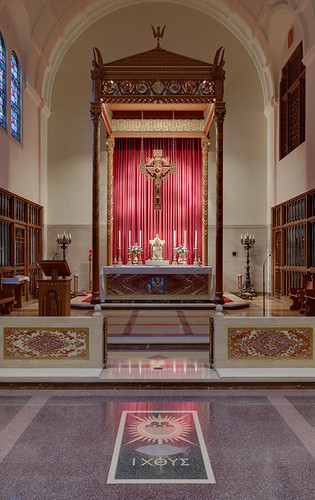
Msgr. Stika was pastor of Annunziata Church, in Ladue, Missouri, which is seen here.
Click here for an article from the United States Conference of Catholic Bishops.
Christmas Photos at Immaculate Heart of Mary Church, in Saint Louis, Missouri

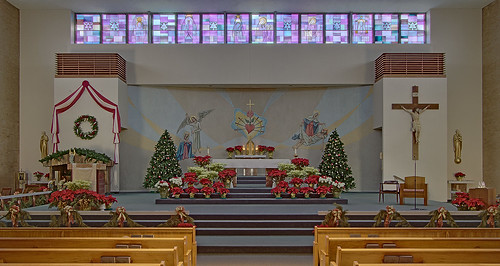
Saturday, January 10, 2009
Yes, it can be done
Looks Familiar
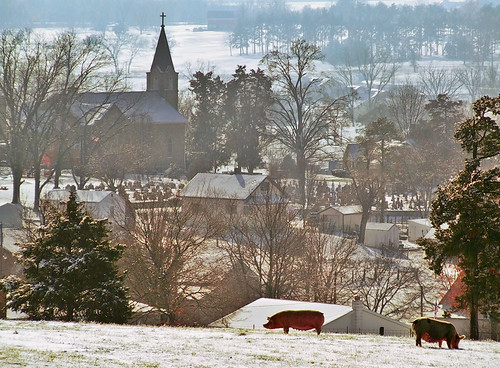
A view of Saint Joseph Church, in Zell, Missouri, which I took on December 17th, 2007.

The cover of the January 2009 issue of the Missouri Historical Review.
Cover Description: Many smaller cities and towns, as well as urban centers, in Missouri became home to German immigrants in the mid- to late nineteenth century, but the new arrivals did not simply strike out on their own; they often followed or were accompanied by family and friends from home. Walter D. Kamphoefner discusses how his research on Missouri’s German heritage led him to the idea of chain migrations to towns like the pictured Zell, Missouri, in “Uprooted or Transplanted? Reflections on Patterns of German Immigration to Missouri,” beginning on page 71. [Mark Abeln, St. Louis, MO]
Thursday, January 08, 2009
Fr. Richard John Neuhaus, R.I.P.
Fr. Richard John Neuhaus slipped away today, January 8, shortly before 10 o’clock, at the age of seventy-two. He never recovered from the weakness that sent him to the hospital the day after Christmas, caused by a series of side effects from the cancer he was suffering. He lost consciousness Tuesday evening after a collapse in his heart rate, and the next day, in the company of friends, he died.
My tears are not for him—for he knew, all his life, that his Redeemer lives, and he has now been gathered by the Lord in whom he trusted.
I weep, rather for all the rest of us. As a priest, as a writer, as a public leader in so many struggles, and as a friend, no one can take his place. The fabric of life has been torn by his death, and it will not be repaired, for those of us who knew him, until that time when everything is mended and all our tears are wiped away.
Funeral arrangements are still being planned; information about the funeral will be made public shortly. Please accept our thanks for all your prayers and good wishes.
In Deepest Sorrow,
Joseph Bottum
Editor
First Things
Photos at the Museum
Wednesday, January 07, 2009
Tuesday, January 06, 2009
Christmas Photos, at the Rectory of Saint George Church, in Hermann, Missouri
